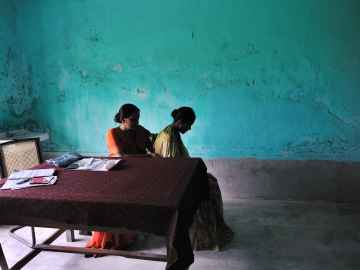False Distinctions Between International Health and Global Health
Over the past 2 decades, the growth in popularity of the term “global health” has been accompanied by various efforts to distinguish it from “international health.” As a result, many misconceptions about the meaning of both terms have cropped up. In particular, fundamental attributes long espoused in international health, such as a focus on health equity and multi-disciplinary approaches, have been claimed by some to be the new and exclusive purview of global health (see this discussion in The Lancet). Whereas the term global health may signal a change in emphasis toward issues that affect everyone around the world, health programs and initiatives using both terms still address health concerns from local to national, international and global levels.
International Health has always had a multidisciplinary, health-equity focus.
In 1978, WHO and UNICEF jointly sponsored the International Conference on Primary Health Care in Alma-Ata, Kazakhstan, with 134 countries and 67 international organizations represented. Before global health ever gained currency as a term, the conference issued the Alma Ata Declaration, widely recognized as one of the major milestones of public health in the 20th century. The declaration called for “Health for All,” recognizing universal approaches and the importance of factors beyond the health sector in overcoming, among other things, the health inequities existing both within and between countries:
- “The Conference strongly reaffirms that health…is a fundamental human right and that the attainment of the highest possible level of health is a most important world-wide social goal whose realization requires the action of many other social and economic sectors in addition to the health sector.”
- “The existing gross inequality in the health status of the people, particularly between developed and developing countries as well as within countries, is politically, socially, and economically unacceptable and is, therefore, of common concern to all countries.”
Transnational cooperation has always been a component of international health. International Health has never defined itself as bilateral aid between nations, although proponents of a distinct term for global health have tried to label it as such. The term international health first came into use in the 19th century. A series of 14 International Sanitary Conferences were held to develop cooperative approaches to epidemic control across and within national borders. In 1903, the 11th such conference called for the creation of an “International health office.” Ultimately, these conferences proved instrumental in the founding of the WHO, which led, among other initiatives, to an international effort to eradicate smallpox. The eradication of smallpox in 1980 relied on an extraordinary collaboration of countries, and, according to former WHO Director-General Margaret Chan, “[it] shows the power of international health cooperation to do great and lasting good.”
International health has also always been linked with nongovernmental action, focusing on locally developed, sustainable solutions. For example, the International Health Commission at the Rockefeller Foundation, founded in 1913, worked in over 80 countries to help combat specific diseases, with a strategy based on building local institutions and strengthening sustainable public health networks, with both government and non-governmental actors.
Bilateral health assistance between governments has been and continues to be part of the world’s health architecture, whether it’s called global or international health. A major component of bilateral aid, however, is actually military aid and has little to do with good health.
Ultimately, neither International Health nor Global Health is an entirely accurate term. But it is important not to create or perpetuate false distinctions between the 2 that do not exist.
In 1961, the Department of International Health at the Johns Hopkins Bloomberg School of Public Health, which I now chair, created the first academic program in this field. It began with a focus on equity, social justice, and ambitions of overcoming nationalism, socioeconomic disparities, and other barriers to health, while promoting international organizations—specifically working with WHO. The approach involved building local capabilities and organizations in collaborative and multi-disciplinary approaches, and training people to be able to work in diverse settings around the world. You can read more about the Department and why we decided to keep our name as Department International Health here.
David Peters, MD, DrPH, MPH is the Edgar Berman Chair and Professor of the Department of International Health at the Johns Hopkins Bloomberg School of Public Health and the Director of the Johns Hopkins Alliance for a Healthier World.
Join the thousands of subscribers who rely on Global Health NOW summaries and exclusive articles for the latest public health news. Sign up for our free weekday enewsletter, and please share the link with friends and colleagues: http://www.globalhealthnow.org/subscribe.html
iStock




